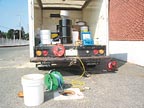
What are the challenges facing the environmental drilling industry in the next 20 years? Cheaper, faster and better are the way things are going. A shift from the HSAs to the direct-push wells will continue especially for shallow wells with shallow water tables.
Advances in portable laboratory equipment has made it possible to analyze most of the compounds of concern using equipment housed in small trailers or vans, run by one person. Samples can be run at a rate of 30 minutes to 45 minutes per sample, with as good or better accuracy (because of short holding times) and detection limits as permanent laboratory facilities. Consultants will be looking for drilling/direct-push companies with laboratory capabilities or contracting with portable laboratories so that the on-site data can guide the drilling activities by having data in minutes rather than three to four weeks.
As more portable labs and direct-push equipment becomes available, the market will become (as it already is) very competitive and the prices will come down. Analytical and some types of drilling costs have not increased and are about the same as they were five to 10 years ago. Buyers already are expecting bid turnaround time within 24 hours or less and the ability to mobilize on even shorter notice.
Cleanliness and decontamination will become more demanding to ensure higher quality soil and ground water samples. The person behind the rig will be even more professional and need to not only do a very good job, but possess excellent people and marketing skills to keep the clients coming back for future drilling contracts.
It would behoove us all to plan ahead for these changes because the challenges will no doubt prove to be challenging.
Report Abusive Comment